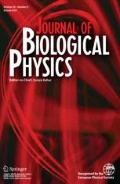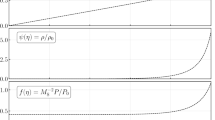Abstract
The Fåhræus-Lindqvist effect is usually explained from a physical point of view with the so-called Haynes’ marginal zone theory, i.e., migration of red blood cells (RBCs) to a core layer surrounded by an annular RBCs-free plasma layer. In this paper we show that the marginal layer, though causing a substantial reduction in flow resistance and increasing discharge, does not reduce the rate of energy dissipation. This fact is not surprising if one considers the electric analog of the flow in a vessel: a resistance reduction increases both the current intensity (i.e., the discharge) and the energy dissipation. This result is obtained by considering six rheological models that relate the blood viscosity to hematocrit (volume fraction occupied by erythrocytes). Some physiological implications are discussed.






Similar content being viewed by others
References
Fåhræus, R., Lindqvist T: The viscosity of the blood in narrow capillary tubes. Am. J. Physiol. 96, 562–568 (1931)
Martini, P., Pierach, A., Scheryer, E.: Die strömung des blutes in engen gefä en. Eine abweichung vom poiseuille’schen gesetz. Dtsch. Arch. Klin. Med. 169, 212–222 (1931)
Pries, A.R., Neuhas, D., Gaehtgens, P.: Blood viscosity in tube flow: dependence on diameter and hematocrit. Am. J. Physiol. Heart Circ. Physiol. 263, H1770–H1778 (1992)
Secomb, T.W., Pries, A.R.: Blood viscosity in microvessels: experiment and theory. C. R. Phys. 14, 470–478 (2013)
Secomb, T.W.: Blood flow in the microcirculation. Annu. Rev. Fluid Mech. 49, 443–461 (2017)
Haynes, R.F.: Physical basis of the dependence of blood viscosity on tube radius. Am. J. Physiol. 198, 1193–1200 (1960)
Fournier, R.L.: Basic Transport Phenomena in Biomedical Engineering. CRC Press, Boca Raton (2012)
Chebbi, R.: Dynamics of blood flow: modeling of the Fåhræus-Lindqvist effect. J. Biol. Phys. 41, 313–326 (2015). https://doi.org/10.1007/s10867-015-9376-1
Sharan, M., Popel, A.S.: A two-phase model for flow of blood in narrow tubes with increased effective viscosity near the wall. Biorheology 38, 415–428 (2001)
Huo, Y., Kassab, G.S.: Effect of compliance and hematocrit on wall shear stress in a model of the entire coronary arterial tree. J. Appl. Physiol. 107, 500–505 (1985)
Xue, X., Patel, M.K., Kersaudy-Kerhoas, M., Bailey, C., Desmulliez, M.P.: Modelling and simulation of the behaviour of a biofluid in a microchannel biochip separator. Comput. Methods Biomech. Biomed. Engin. 14, 549–560 (2011)
Fasano, A., Sequeira, A.: Hemomath. The Mathematics of Blood, Springer (2017)
Mansour, M.H., Bressloff, N.W., Shearman, C.P.: Red blood cell migration in microvessels. Biorheology 47, 73–93 (2010). https://doi.org/10.3233/BIR-2010-0560
Chebbi, R.: Dynamics of blood flow: Modeling of Fåhraeus and Fåhraeus–Lindqvist effects using a shear-induced red blood cell migration model. J. Biol. Phys. 44, 591–603 (2018). https://doi.org/10.1007/s10867-018-9508-5
Leighton, D., Acrivos, A: The shear-induced migration of particles in concentrated suspensions. J. Fluid Mech. 181, 415–427 (1987)
Nott, P.R., Brady, J.F.: Pressure-driven flow of suspensions: simulation and theory. J. Fluid Mech. 275, 157–199 (1994)
Phillips, R.J., Armstrong, R.C., Brown, R.A.: A constitutive equation for concentrated suspensions that accounts for shear-induced particle migration. Phys. Fluids 4, 30–40 (1992)
Pranay, P., Henriquez-Rivera, R.G., Graham, M.D.: Depletion layer formation in suspensions of elastic capsules in Newtonian and viscoelastic fluids. Phys. Fluids 24 (06), 2012 (1902)
Monsorno, D., Varsakelis, C., Papalexandris, M.V.: A thermomechanical model for granular suspensions. J. Fluid Mech. 808, 410–440 (2016)
Monsorno, D., Varsakelis, C., Papalexandris, M.V.: Poiseuille flow of dense non-colloidal suspensions: The role of intergranular and nonlocal stresses in particle migration. J. Non-Newtonian Fluid Mech. 247, 229–238 (2017)
Lecampion, B., Garagash, D.I.: Confined flow of suspensions modelled by a frictional rheology. J. Fluid Mech. 759, 197–235 (2014)
Boyer, F., Guazzelli, E., Pouliquen, O.: Unifying suspension and granular rheology. Phys. Rev. Lett. 107, 188301 (2011)
Ahnert, T., Münch, A., Wagner, B.: Models for the two-phase flow of concentrated suspensions. Eur. J. Appl. Math 30, 585–617 (2019)
Rajagopal, K.R., Tao, L.: Mechanics of Mixtures. World Scientific, Singapore (1995)
Drew, D.A., Passman S.L.: Theory of Multicomponent Fluids, Applied Mathematical Sciences, vol. 135. Springer (1999)
Anand, M., Rajagopal, K.R.A.: Note on the flows of inhomogeneous fluids with shear-dependent viscosities. Arch. Mech. 57, 417–428 (2005)
Fusi, L., Farina, A., Rosso, F., Rajagopal, K.: Thin-film flow of an inhomogeneous fluid with density-dependent viscosity. Fluids 4, 30 (2019)
Massoudi, M.: Vaidya A. Unsteady flows of inhomogeneous incompressible fluids. Int. J. Non-Linear. Mech. 46, 738–741 (2011)
Segré, G., Sileberger, A.: Behaviour of macroscopic rigid spheres in Poiseuille flow. J. Fluid Mech. 14, 115–135 (1962)
Secomb, T.W.: Mechanics of red blood cells and blood flow in narrow tubes. In: Pozrikidis, C. (ed.) Modeling and Simulation of Capsules and Biological Cells, pp 163–196. CRC, Boca Raton (2003)
Coupier, G., Kaoui, B., Podgorski, T., Misbah, C.: Noninertial lateral migration of vesicles in bounded Poiseuille flow. Phys. Fluids 20, 111702 (2008)
Doddi, S.K., Bagchi, P.: Three-dimensional computational modeling of multiple deformable cells flowing in microvessels. Phys. Rev. E 79, 046318 (2009)
Kaoui, B., Ristow, G.H., Cantat, I., Misbah, C., Zimmermann, W.: Lateral migration of a two-dimensional vesicle in unbounded Poiseuille flow. Phys. Rev. E 77(02), 2008 (1903)
Goldsmith, H.L.: Red cell motions wall interactions in tube flow. Fed Proc. 30, 1578–1590 (1971)
Moyers-Gonzalez, M.A., Owens, R.G.: Mathematical modelling of the cell-depleted peripheral layer in the steady flow of blood in a tube. Biorheology 47, 39–71 (2010)
Moyers-Gonzalez, M.A., Owens, R.G., Fang, J.: A non-homogeneous constitutive model for human blood. Part I: Model derivation and steady flow. J. Fluid Mech. 617, 327–354 (2008)
Dimakopoulos, Y., Kelesidis, G., Tsouka, S., Georgiou, G.C., Tsamopoulos, J.: Hemodynamics in stenotic vessels of small diameter under steady state conditions: effect of viscoelasticity and migration of red blood cells. Biorheology 52, 183–210 (2015)
Brust, M., Schaefer, C., Doerr, R., Pan, L., Garcia, M., Arratia, P.E., Wagner, C.: Rheology of human blood plasma: viscoelastic versus Newtonian behavior. Phys. Rev. Lett. 110, 078305 (2013)
Varchanis, S., Dimakopoulos, Y., Wagner, C., Tsamopoulos, J.: How viscoelastic is human blood plasma? Soft Matter 14, 4238–4251 (2018)
Drew, D.A.: Flow structure in the Poiseuille flow of a particle-fluid mixture, SIAM Workshop on Multiphase Flow, June 2–4 (1986)
Graham, A.L., Altobelli, S.A., Fukushima, E., Mondy, L.A., Stephens, T.S.: Note: NMR imaging of shear-induced diffusion and structure in concentrated suspensions undergoing Couette flow. J. Rheol. 35, 191–198 (1991)
Karnis, A., Goldsmith, H.L., Mason, S.G.: The kinetics of flowing dispersions: I. Concentrated Suspensions of rigid particles. J. Colloid and Interf. Sci. 22, 531–543 (1966)
Pries, A.R., Secomb, T.W., Geßner, T., Sperandio, M.B., Gross, J.F., Gaehtgens, P.: Resistance to blood flow in microvessels in vivo. Circ. Res. 75, 904–915 (1994)
Wells, R.E., Merrill, E.W.: Influence of flow properties of blood upon viscosity-hematocrit relationships. J. Clin. Investig. 41, 1591–1598 (1962)
Goldsmith, H.L., Cokelet, G.R., Gaehtgens, P.: Robin Fåhraeus: evolution of his concepts in cardiovascular physiology. Am. J. Physiol. Heart. Circ. Physiol. 257, H1005–H1015 (1989)
Secomb, T.W., Hsu, R., Pries, A.R.: Effect of the endothelial surface layer on transmission of fluid shear stress to endothelial cells. Biorheology 38, 143–50 (2001)
Secomb, T.W., Hsu, R., Pries, A.R.: Motion of red blood cells in a capillary with an endothelial surface layer: effect of flow velocity. Am. J. Physiol. Heart Circ. Physiol. 281, H629–636 (2001)
Yeleswarapu, K.K., Kameneva, M.V., Rajagopal, K.R., Antaki, J.F.: The blood flow in tubes: theory and experiments. Mech. Res. Commun. 25, 257–262 (1998)
Goldsmith, H.L., Marlow, J.C.: Flow behavior of erythrocytes. II. Particle motions in concentrated suspensions of ghost cells. J. Colloid and Interface Sci. 71, 383–407 (1979)
Liepsch, D.W.: Flow in tubes and arteries - a comparison. Biorheology 23, 395–402 (1986)
Truesdell, C., Rajagopal, K.R.: An Introduction to the Mechanics of Fluids. Birkhauser, Boston (1999)
Bayliss, L.E.: Reology of blood and lymph, in Deformation and Flow in Biological Systems. Frey-Wyssling ed., North-Holland (1952)
Hund, S.J., Kameneva, M.V., Antaki, J.F.: A quasi-mechanistic mathematical representation for blood viscosity. Fluids 2, 10–36 (2017)
Charm, S.E., Kurland, G.S.: Blood Flow and Microcirculation, Wiley (1974)
Hatschek, E.: Eine reihe von abnormen Liesegangschen Schictung. Koll. Zeitschr 27, 225–229 (1920)
Cokelet, G.R.: The Rheology of Human Blood, Doctoral dissertation, M.I.T, Cambridge, MA (1963)
Bingham, E.C., White, G.F., Amer, J.: The viscosity and fluidity of emulsions, crystallin liquids and colloidal solutions. Chem. Soc. 33, 1257–1275 (1911)
Nubar, Y.: Effect of slip on the rheology of a composite fluid: application to blood. Biorheology 4, 113–117 (1967)
Krieger, I.M., Dougherty, T.J.: A mechanism for non-Newtonian flow in suspensions of rigid spheres. Trans. Soc. Rheol. 3, 137–152 (1959)
Liu, A.J., Nage, S.R.: The jamming transition and the marginally jammed solid, Annual. Rev. Condens. Matter Phys. 1, 347–369 (2010)
Dix, F.J., Scott Blair, G.W.: On the flow of suspensions through narrow tubes. J. Appl. Physics 11, 574–581 (1940)
Oiknine, C., Azelvandre, F.: Scott Blair model and Fahraeus-Lindqvist effect. Rheol. Acta 14, 51–52 (1975)
Snyder, G.K.: Erythrocyte evolution: the significance of the Fåhraeus-Lindqvist phenomenon. Respir. Physiol. 19, 271–278 (1973)
Author information
Authors and Affiliations
Corresponding author
Ethics declarations
Conflict of interest
The authors declare that they have no conflicts of interest.
Additional information
Publisher’s note
Springer Nature remains neutral with regard to jurisdictional claims in published maps and institutional affiliations.
Rights and permissions
About this article
Cite this article
Ascolese, M., Farina, A. & Fasano, A. The Fåhræus-Lindqvist effect in small blood vessels: how does it help the heart?. J Biol Phys 45, 379–394 (2019). https://doi.org/10.1007/s10867-019-09534-4
Received:
Accepted:
Published:
Issue Date:
DOI: https://doi.org/10.1007/s10867-019-09534-4




